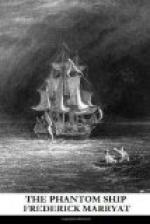On the wall facing the window were other prints, in frames equally veiled in damp and cobwebs, and also two bird-cages. The bird-cages Philip approached, and looked into them. The occupants, of course, had long been dead; but at the bottom of the cages was a small heap of yellow feathers, through which the little white bones of the skeletons were to be seen, proving that they had been brought from the Canary Isles; and, at that period, such birds were highly valued. Philip appeared to wish to examine everything before he sought that which he most dreaded, yet most wished, to find. There were several chairs round the room: on one of them was some linen; he took it up. It was some that must have belonged to him when he was yet a child. At last, Philip turned his eyes to the wall not yet examined (that opposite the chimney-piece), through which the door was pierced, and behind the door as it lay open, he was to find the table, the couch, the workbox, and the FATAL LETTER. As he turned round, his pulse, which had gradually recovered its regular motion, beat more quickly; but he made the effort, and it was over. At first he examined the walls, against which were hung swords and pistols of various sorts, but chiefly Asiatic bows and arrows, and other implements of destruction. Philip’s eyes gradually descended upon the table, and little couch behind it, where his mother stated herself to have been seated when his father made his awful visit. The workbox and all its implements were on the table, just as she had left them. The keys she mentioned were also lying there, but Philip looked, and looked again; there was no letter. He now advanced nearer, examined closely—there was none that he could perceive, either on the couch or on the table—or on the floor. He lifted up the workbox to ascertain if it was beneath—but no. He examined among its contents, but no letter was there. He turned over the pillows of the couch, but still there was no letter to be found. And Philip felt as if there had been a heavy load removed from his panting chest. “Surely, then,” thought he,




